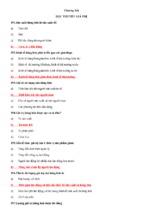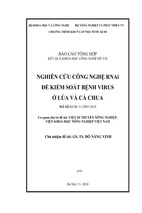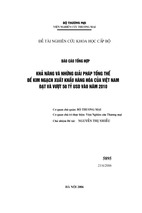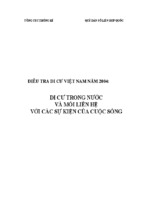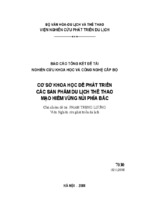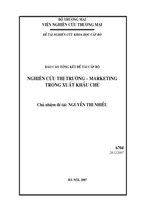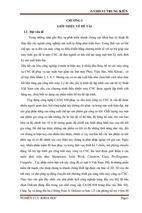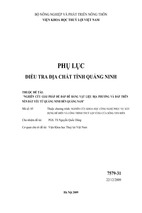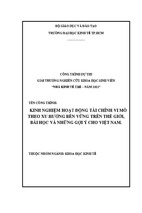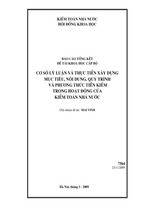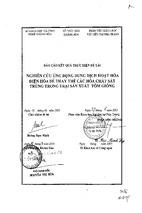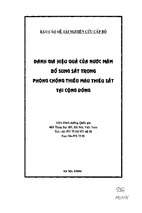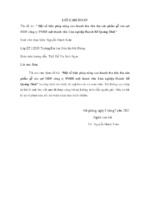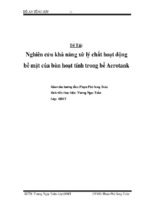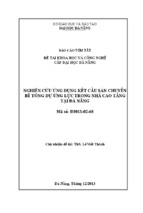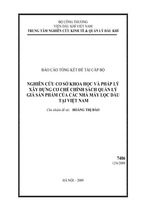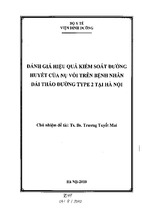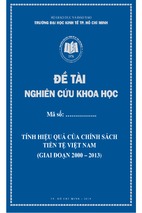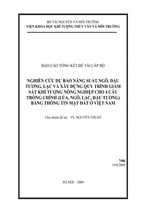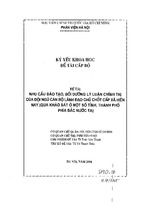VEPR Working Paper
WP-07
Impact of Stimulus Package on Firm-level Performance
An Econometric Assessment from 2009 PCI Data for Vietnam
To Trung Thanh and VEPR Research Team
© 2010 Vietnam Centre for Economic and Policy Research
University of Economics and Business, Vietnam National University Hanoi
WP-07
Impact of Stimulus Package on Firm-level Performance
An Econometric Assessment from 2009 PCI Data for Vietnam*
To Trung Thanh† and VEPR Research Team
Abstract
Our analyses on the PCI 2009 survey show that the positive impacts of
the loan subsidy program upon firm performance is not very significant. The
size of impact on labor employed before and after the subsidy program introduced is found to be relatively small. Firms in the mining sector or of medium
size seem to have a propensity to employ more labor rather than have more
investment in machinery or equipment. This might imply that the subsidy package
has helped these firms in short-term performance but not in the longer term.
Keywords: Interest subsidy, stimulus package, Vietnam.
*
This paper is mainly extracted from a VEPR report submitted to Vietnam Competitiveness Initiative (VNCI)
on January 2010. We would like to thank VNCI for kindly providing us a full dataset of the PCI 2009 survey to
conduct relevant analyses.
†
Lecturer at Faculty of Economics, National Economics University; Email:
[email protected].
1
Content
Introduction................................................................................................................................3
Methodology and Variables.......................................................................................................3
Methodology ....................................................................................................................................... 3
Variables ............................................................................................................................................. 5
Estimation Results .....................................................................................................................6
Regression Method ............................................................................................................................. 6
“Propensity Score” Method ................................................................................................................ 8
Conclusions and Implications ..................................................................................................11
References................................................................................................................................13
Tables
Table 1. Definition and Measurement of Variables...................................................................6
Table 2. Estimated Coefficients of Regression Model (2).........................................................7
Table 3. Logit Model of Access to Interest rate Subsidy Program............................................8
Table 4. Impact of Interest rate Subsidy Package on Firms’ Outcomes..................................10
Table 5. Interest Rate Subsidy Impacts by Different Characteristics ......................................11
2
Introduction
Earlier 2009, in the midst of the world crisis, the Vietnamese Government launched an
economic stimulus package worth US$ 8 billion to support domestic enterprises suffering
from the global economic downturn. The package included tax incentives, public investments
in infrastructure, and, of particular interest, 4% interest rate subsidy program. The interest
rate subsidy scheme is unique in the world, thus it has been paid much attention and among
endless controversies on its impact on the domestic economy.
Most of the previous studies have applied qualitative analysis or computable general
equilibrium modeling technique to investigate the macroeconomic effects of the stimulus
package‡. Given the 2009 PCI datasets, in which 3,225 of the 9,890 respondents received the
4% interest rate subsidy, the stimulus package evaluation at the firm level would be feasible,
and this helps to get more convincing conclusions on the effects of this policy on private
investment, performance and growth. That is also the objective of this study, which is
structured into three main parts. The first part presents the rational for methodology and
description of variables. Next come the estimation results and comments, and the study is
finalized by conclusions and implications.
Methodology and Variables
Methodology
Denote G as the expected gain in firm performance due to interest rate subsidy program,
then
G = E(R1i – R0i|Pi=1) (1)
where Pi is the ith firm’s access to subsidy, which takes the value 1 if the firm
participates in program, and 0 otherwise, R1i (R0i) is the performance outcome of the ith firm
if the firm access (does not access) to subsidy. G is the conditional mean impact, conditional
on accessing to the subsidy program, which is called the treatment effect. To estimate G,
there are two possible methods that we apply for this study.
‡
See Nguyen Duc Thanh et al. (2008), Nguyen Thi Nhung and Ha Thi Hieu Dao (2009), James and Hoang Nhi
(2009).
3
The first method is to estimate the regression: Ri = a + bPi + cXi + ei (2), where Xi are
observable characteristics of the ith firm that could determine the firm’s performance
outcome. The regression itself controls the different characteristics of firms and let the
estimated coefficient b be understood as the program impact on firms’ performance.
However, there might be a problem of endogeneity in that regression, and instrumental
variable technique rather than OLS technique should be applied in that case. The instrumental
variables are variables that matter to program participation but not to outcomes given
participation. It is, nevertheless, difficult to identify those variables and given limited relevant
datasets can not provide such variables even when those are identified. In addition, this
method makes strong assumptions about regression functional form. Therefore, besides this
method, we also make use the second method for result robustness.
The second method to deal with subsidy program evaluation is to compute the difference
in performance outcome between participants (treatment group) and a comparison group.
Because we can not observe the performance of participants if they had not accessed to
subsidy, the comparison group has to be extracted from non-participants. This group is used
to identify the counterfactual of what would have happened without the program. The
comparison group should be very similar to the participants in terms of characteristics and
the only one main difference between these two groups is whether they access to subsidy
package or not.
Identifying this comparison group, however, is not easy task due to some possible
biases. The first type of biases is due to differences in unobservable characteristics. For given
values of observable characteristics (Xi), there could be a systematic relationship between
subsidy package participation and outcomes in the absence of program. In other words, there
could be some unobservable variables which jointly affect the outcomes and participation
conditional on the observed variables. In this case, one should apply “double difference”
method§, which compares the treatment group and the comparison group (first difference)
before and after the subsidy program (second difference). To apply this method, there must
be a panel data where outcomes and the determinants both before and after the program
introduced are collected, for both treated and untreated groups. Due to the data availability,
we cannot apply this method.
§
See more in Imbens and Wooldridge (2008).
4
The second type of biases is due to observable characteristics, where the set of control
variables for which outcomes and participation are observed is different between the
treatment group and the comparison group. This bias will be eliminated if one could find a
sample of non-participants with the same characteristics (Xi) as the treatment group. Given
many variables to be controlled, it seems to be impossible to find a non-participant with
exactly the same all observables for a participant. To deal with that problem, instead of
matching all variables (Xi) to ensure they are the same for both participants and nonparticipants, we match the probability of accessing the subsidy program, given Xi. Applying
this so called “propensity score” method**, we follow steps as follows:
•
Estimating a logit model of program access as a function of the variables that
are likely to determine the participation, then calculate the predicted probability of access
(propensity scores).
•
For each firm in the participant sample, we find five firms in the non-
participant sample that have the closest propensity scores (five nearest neighbors).
•
Computing mean value of outcomes of five nearest neighbors and the
difference between that mean and the actual value of the treated firm is the estimated gain
due to program access.
•
The mean of all individual firm gains could represent for the general impact of
stimulus package on firms’ performance outcomes. This is also stratified by some
variables of interest to get more insight on the stimulus package impact.
Variables
Two datasets available for the analysis include PCI firm-level and PCI provincial-level
datasets, with the main objective of describing firms perceptions of their local business
environments. Therefore, these datasets do not provide rich data on firms’ performances and
characteristics in continuous forms. Given data limitation, Table 1 shows the definition and
measurement of observable characteristics (Xi) and the performance outcomes (Ri), which
will be used for the two applied methods.
**
See more in Rosenbaum and Rubin (1983) and Imbens and Wooldridge (2008).
5
Table 1. Definition and Measurement of Variables
Variables
Experience
Ownership types
Sectors
Xi
Firm size
Market orientation
Regional
characteristics
Change in employment
Ri
Change in number of
employment
Change in capital
Business plan in next
two years
Definition and Measurement
Years of operation, computed from the year established
Dummy variables with four types: i) sole proprietorship, ii) limited
liability, iii) joint stocks, iv) all other types
Dummy variables with four sectors: i) industry/manufacturing/construction,
ii) service/commerce, iii) agriculture/forestry/aquaculture, iv) mining and
all others
Dummy variables with four sizes: i) super-small, ii) small, iii) medium and
iv) large. The size categories are defined following Decree 56/2009/NĐCP††
Dummy variable with two orientations: i) inward-oriented if the percentage
of domestic sale is more than 50% and ii) export-oriented otherwise.
All PCI sub-indexes that explain variation in performance across provinces.
These could control for the regional characteristics that have impact on
firms’ outcomes.
Change in the ordered categories of employment‡‡ between the year 2008
(before the stimulus package introduced) and the time of survey (after the
package introduced)
Change in the number of labor from the year 2008 (before the stimulus
package introduced) and the time of survey (after the package introduced)
Change in the ordered categories of capital§§ between the year 2008 (before
the stimulus package introduced) and the time of survey (after the package
introduced)
Dummy variables with four plans: i) increase size of operation, ii) decrease
size of operation, iii) keep the same size of operation, iv) close the business
Estimation Results
Regression Method
Table 2 presents the regression of change in employment number, following Equation 2
with various versions to check robustness.
In all versions of regression, some characteristics have statistically significant effects on
firm outcome. Small and medium sized firms tend to perform better than larger sized ones.
Inward-oriented enterprises seem to have employed more labors than export-oriented firms,
possibly because the latter firms have been more affected from the global crisis than the
former. Firms in the provinces with lack of bias against private sector seem to get better
outcomes, implying the importance of private sector friendly environment on business
††
We use number of employment as the criterion to classify firm size because the capital variables in the
datasets are not matching with classifications in this Decree.
‡‡
In the survey, the firm’s employment is ordered in the categories from 1 till 8, corresponding to (<5), (5-8),
(10-48), (50-188), (200-288), (300-488), (500-1000) and (>1000) labors.
§§
In the survey, the firm’s capital is ordered in the categories from 1 till 8, corresponding to (<0.5), (0.5-1), (15), (5-10), (10-50), (50-200), (200-500), and (>500) VND billions.
6
activities. Meanwhile, experience, ownership types and sectors of the firms are found not to
have impact on employment change during 2008-2009.
Table 2. Estimated Coefficients of Regression Model (2)
Access to stimulus package
Experience
Ownership types
Sole proprietorship
Limited liability
Joint stock
Sectors
Industry/manufacturing/construction
Services/commerce
Agriculture/forestry/aquaculture
Firm size
Super small
Small
Medium
Inward-oriented
Regional features
Entry costs
Land access and tenure
Transparency
Time costs
Informal charges
Lack of bias against private sector
Pro-activity
Business support services
Labor policy
Legal institutions
Infrastructure
Constant
R-squared
(1)
3.74**
-0.01
(2)
3.96**
-0.01
(3)
3.96**
-0.46
4.09
4.43
6.52
4.14
4.45
6.61
0.92
1.00
1.42
0.24
1.52
-0.55
0.32
1.50
-0.35
6.77**
7.18**
9.62**
12.47**
6.95**
7.46**
9.79**
12.73**
-0.11
1.08
-0.28
-0.20
0.51
1.10**
-0.37
0.68
0.10
0.23
-0.03
-38.41**
0.01
-25.55**
0.01
(4)
3.94**
-0.44
(5)
3.96**
(6)
3.96**
4.15
4.47
6.62
0.28
0.98
-0.19
0.33
1.51
-0.34
2.50**
2.67**
3.29**
6.13**
2.05**
2.44**
3.03**
5.99**
7.03**
7.53**
9.83**
12.72**
6.08**
6.65**
9.94**
13.31**
-4.74**
0.01
-6.20**
0.01
-25.70**
0.01
-19.73**
0.01
Notes: **: statistically significant at 5% level.
The coefficient of interest, access to interest-rate subsidy scheme, with all other
observable variables (Xi) controlled, is positive and statistically significant at 5% level. This
implies that the stimulus package has had positive impact on firm performance outcomes in
terms of employment change. However, the size of impact seems to be slightly small.
According to all regression versions, on average, participants have increased employment by
only 4 more labors than non-participants, as a result of accessing to interest rate subsidy
package. Due to some possible problems in this method as specified in the previous part, we
also consult the next method to get more convincing conclusions.
7
“Propensity Score” Method
Table 3. Logit Model of Access to Interest rate Subsidy Program
Access to stimulus packages
Experience
Types
Sole proprietorship
Coefficient
0.0009
0.8421***
Standard Error
0.0007
0.2555
z
1.2200
3.3000
P>z
0.2210
0.0010
Limited liability
Joint stock
0.7827***
0.8428***
0.2547
0.2576
3.0700
3.2700
0.0020
0.0010
Industry/manufacturing/construction
Services/commerce
0.1417**
0.2277***
0.0679
0.0689
2.0900
3.3100
0.0370
0.0010
Agriculture/forestry/aquaculture
Supers mall
0.2301**
-0.5021***
0.0927
0.0790
2.4800
-6.3500
0.0130
0.0000
Small
Medium
0.2877***
0.8175***
0.0719
0.1067
4.0000
7.6600
0.0000
0.0000
-0.5696***
-0.1015**
0.0976
0.0450
-5.8400
-2.2600
0.0000
0.0240
0.1397***
0.0490
0.0343
0.0318
4.0800
1.5400
0.0000
0.1230
0.0239
-0.0786*
0.0293
0.0452
0.8200
-1.7400
0.4140
0.0820
Lack of bias against private sector
Pro-activity
0.1246***
-0.0739***
0.0254
0.0222
4.9000
-3.3300
0.0000
0.0010
Business support services
Labor policy
-0.1616***
-0.0053
0.0307
0.0420
-5.2600
-0.1300
0.0000
0.8990
0.0392
-0.0064
0.0344
0.0043
1.1400
-1.5100
0.2560
0.1300
-0.4534
0.5578
-0.8100
0.4160
Sectors
Sizes
Inward-oriented
Regional
Entry costs
reatures
Land access and tenure
Transparency
Time costs
Informal charges
Legal institutions
Infrastructure
Constant
Notes: Pseudo R2 = 0.0465: ***, **, *: statistically significant at 1%, 5% and 10% levels
Table 3 shows the logit model as the first step of this method, in which, the determinants
of access to program are identified. Accordingly, firm experience and some regional features
are likely not to have impact on probability of accessing subsidy, meanwhile ownership
types, sectors, size, market orientation and some PCI sub-indexes are found to be the
significant determinants of subsidy access.
In detail, sole proprietorship, limited liability and joint stocks enterprises have more
propensity to participate in the subsidy program than all other ownership. Firms in the
agriculture, forestry and aquaculture sector have the highest probability to access to subsidy,
8
possibly because one of the package objectives is towards this sector***, meanwhile mining
firms get less access to the stimulus than all other sectors. Super-small firms with less than 10
workers seem to get difficult in approaching the subsidy package, whereas medium size firms
(50-200 labors in trade sector and 200-300 labors in other sectors) have the highest
propensity to subsidized loans. Export-oriented firms are found to have higher access
probability than inward-oriented ones, possibly because the former have more rational to
access to program due to badly affected by the world crisis. In terms of regional
characteristics, firms located in provinces with lower entry cost sub-index, higher land access
and tenure sub-index, lower informal charge sub-index, higher sub-index of lack of bias
against private sector, lower pro-activity sub-index and lower business support services subindex have more probability to access the interest rate subsidy.
Table 4 presents the policy evaluation, following the “propensity score” method. All
numbers in the table are understood as the mean of difference in outcomes between
participants and the comparison group, which is now representing the program’s impact. It
should be noted that except for change in labors employed, all other performance variables
are the forms of ordered categories or dummy variable, thus the mean value of change in
these variables during 2008-2009 and then policy evaluation on those variables will be
assessed based on the sign of impact rather the value.
As revealed by Table 4, the policy impacts on employment and capital are positive,
implying that the interest rate subsidy has helped enterprises to employ more labors and
invest more capital for the business. The impact of number of labors employed is found to be
3.27, implying that, on average, the participants tend to employ 3 – 4 more labors due to the
stimulus package, which is comparable to policy impact estimated in the regression method.
This size of impact, thus, is slightly small. In addition, firms accessing to the stimulus
package are found to have more optimistic attitudes toward future business. More participants
are likely to plan to expand operation size in the next two years rather than decrease or keep
the current operation or close the business.
***
See Decree 497/QĐ-TTg dated on 17 April 2009.
9
Table 4. Impact of Interest rate Subsidy Package on Firms’ Outcomes
Impact on employment
Impact on
performance outcomes Impact on number of employment
Impact on capital
Impact on plan in the
Increase operation size
next two years
Decrease operation size
Keep current operation size
Close the business
Mean
0.04
3.27
0.04
0.05
-0.03
-0.01
-0.01
Std. Dev.
0.42
41.5
0.49
0.51
0.50
0.17
0.14
Table 5 provides more insight about the policy impact across different categories of
firms. In terms of employment, most of the categories have employed more labors as a
consequence of accessing subsidized loans, except for firms in other types of ownership such
as household, cooperative, and firms in the agriculture, forestry and aquaculture sector. The
firms on other types have performed badly not only in employment but also in capital change
due to access to the subsidy program. This raises a suspicious question on how these firms
have utilized the subsidized loans. Meanwhile, the firms in agriculture, forestry and
aquaculture sector, though employed less labors, have gained in capital change and this
impact is even highest across different sectors. This fact seems to reflect one of the package
stimulus’s objectives, which is giving more supports for firms in this sector to buy machinery
and other mechanical equipments. Table 5 also reveals that firms with experience of less than
10 years, in joint stocks type, in mining sector, of large size, in inward-oriented category, or
in haft bottom PCI ranking provinces are likely to get highest subsidy impacts on
employment changes within corresponding categories.
In terms of capital change, Table 5 shows some negative policy impacts. Firms in the
mining sector seem to employ more labors but their capital ranking categories decrease.
Medium-size firms, and to lesser extent, large-size firms and export-oriented firms share
similar program impacts. The variable of capital in the data survey do not provide
information on how much it is spent for working capital and how much for fixed capital.
However, given the fact that they have expanded employment size, their investment on
machinery and equipment may be decreased.
10
Table 5. Interest Rate Subsidy Impacts by Different Characteristics
Impact on
employment
Experience
Ownership Types
Sectors
Size
Market-orientation
PCI ranking
provinces
>10 years
<=10 years
Sole proprietorship
Limited liability
Joint stock
Others
Industry/
manufacturing/construction
Services/commerce
Agriculture, forestry and
aquaculture
Mining and others
Super small
Small
Medium
Large
Inward-oriented
Export-oriented
Group of 25% top
Group of second 25%
Group of third 25%
Group of 25% bottom
0.03
0.05
0.01
0.06
0.08
-0.23
0.09
Impact on
number of
employment
0.56
3.76
1.38
3.65
5.4
-0.12
5.09
Impact on
capital
0.03
0.07
3.6
-1.87
0.04
0.13
0.01
0.05
0.04
0.06
0.03
0.04
0.07
0.04
0.01
0.07
0.06
9.22
0.61
2.79
7.38
11.15
3.42
1.53
1.64
2.63
4.84
4.01
-0.06
0.07
0.04
-0.02
-0.002
0.04
-0.003
0.05
0.02
0.06
0.01
0.03
0.04
0.05
0.04
0.01
-0.11
0.02
Notes: The bold numbers indicate the negative policy impacts.
Conclusions and Implications
Both two methods of analysis reveal the positive impacts of 4% interest rate subsidy
package on employment and capital changes in the private sector. As a result of receiving
subsidized loan, in general, firms seem to employ more labors, increase capital, and their
attitudes toward future business plan appear more optimistic. The size of package impact on
capital and then investment can not be computed, because the variables of capital in the
survey are in the form of ordered categories rather than the real value. Meanwhile the size of
impact on labors employed before and after the subsidy program introduced is found to be
slightly small. However, these findings at least illustrate the package’s credit for a good
response to economic recession, helping private sector’s employment not to decrease during the
downturn.
11
By ownership type, the firms of other types except sole proprietorship, limited liability
and joint stocks are likely not to gain higher employment and capital. Due to lack of authority
control over this type of firms, there is a possibility that some money from subsidized loan
may not be used for productive new investments. If that sum of money ends up in the stock
market or real estate, this could create the bubbles, then negatively affecting the domestic
economy. The next stimulus package, therefore, should more carefully define the types of
firms qualified for the subsidy to make sure the money directed to the right way.
Firms in the mining sector or of medium size seem to have propensity to employ more
labors rather than increase more investment in machinery or equipment. This might imply
that the subsidy package has helped these firms in short-term performance but not in the
longer term. Due to negative program impact on firm capital, we do not exclude the
possibility that part of subsidized loans may be directed to other objectives other than to new
investments. Therefore, more firm regulations of how subsidized loans are used and more
administration over the loans to these types of firms should be helpful for the success of the
next stimulus packages.
12
References
Dehejia, Rajeev H., and Sadek Wahba. 1999. “Causal Effects in Non-Experimental Studies:
Re-Evaluating the Evaluation of Training Programs.” Journal of the American Statistical
Association 94:1053-62.
Grossman, Jean Baldwin. 1994. “Evaluating Social Policies: Principles and U.S. Experience.”
World Bank Research Observer 9(2):159-80.
Heckman, James. 1997. “Instrumental Variables. A Study of Implicit behavioral Assumption
Used in Making Program Evaluations.: Journal of Human Resources 32(3):441-61.
Imbens, G. and J. Wooldridge. 2008. “Recent Developments in the Econometrics of Program
Evaluation”. IZA DP No. 3640
James, A. and Hoang Nhi. 2009. “An Economic Analysis of Vietnam’s Fiscal Stimulus
Package”, Vietnam Socioeconomic Development Review No 58 June 2009.
Nguyễn Đức Thành, Bùi Trinh, Phạm Thế Anh, Đinh Tuấn Minh, Bùi Bá Cường, Dương
Mạnh Hùng. 2008. “Về chính sách chống suy thoái ở Việt Nam hiện nay: Nghiên cứu số
1: Chính sách kích cầu”, Bài thảo luận chính sách VEPR CS-04/2008
Nguyễn Thị Nhung, Hạ Thị Hiều Dao. 2009. “Đánh giá hiệu quả của chính sách kích cầu
chống suy giảm kinh tế ở Việt Nam”, Tạp chí Ngân hàng, số 24 tháng 12 – 2009.
Moffitt, Robert. 1991. “Program Evaluation with Nonexperimental Data.” Evaluation Review
15(3):291-314.
Rosenbaum, P., and D. Rubin. 1983. “The Central Role of the Propensity Score in
Observational Studies for Causal Effects.” Biometrika 70:41-55.
13
14


